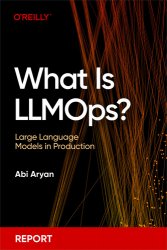What Is LLMOps?
- Добавил: literator
- Дата: 9-05-2024, 02:38
- Комментариев: 0
 Название: What Is LLMOps? Large Language Models in Production
Название: What Is LLMOps? Large Language Models in ProductionАвтор: Abi Aryan
Издательство: O’Reilly Media, Inc.
Год: 2024-05-03
Язык: английский
Формат: pdf, azw3, epub, mobi
Размер: 10.1 MB
Large language models (LLMs), a subcategory of Generative AI, have taken the world by storm. Commonly known for their application in ChatGPT, LLMs have unleashed new energy among developers and businesses looking to integrate AI into their applications. But the internet is also full of disjointed information about LLM applications and how to integrate and deploy them reliably into products and applications.
A large language model (LLM) is a statistical model trained on large amounts of text data to emulate human speech for natural language processing (NLP) tasks, such as information extraction, text classification, speech synthesis, summarization, and machine translation. LLMOps, thus, is a framework to automate and streamline large language model (also called a foundational or generative AI model) pipelines. While task-specific models for natural language processing (NLP) have been used in practice for a while, recent advances in NLP have shifted public interest to more task-agnostic models that allow a single model to do all of the tasks listed in the preceding paragraph.
LLMs show remarkable performance at programming and coding, due to their capacity for context understanding and syntax awareness. Programming is a highly autoregressive task (i.e., it looks at the previous word to predict the next one), such that code completion is based on previous code elements in the sequence. LLMs, being naturally autoregressive, perform well at autocompleting code snippets to generate syntactically accurate code, drawing on patterns learned from vast repositories of code examples from GitHub or otherwise. These models are also language-agnostic, offering great flexibility for working across multiple programming languages. LLMs’ natural language capabilities allow them to learn semantics, the inherent and inferred meanings that connect English and various programming languages. This allows them to generate and debug code from natural language prompts.
Contents:
Скачать What Is LLMOps?
Внимание
Уважаемый посетитель, Вы зашли на сайт как незарегистрированный пользователь.
Мы рекомендуем Вам зарегистрироваться либо войти на сайт под своим именем.
Уважаемый посетитель, Вы зашли на сайт как незарегистрированный пользователь.
Мы рекомендуем Вам зарегистрироваться либо войти на сайт под своим именем.
Информация
Посетители, находящиеся в группе Гости, не могут оставлять комментарии к данной публикации.
Посетители, находящиеся в группе Гости, не могут оставлять комментарии к данной публикации.

